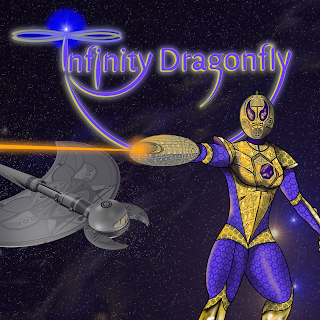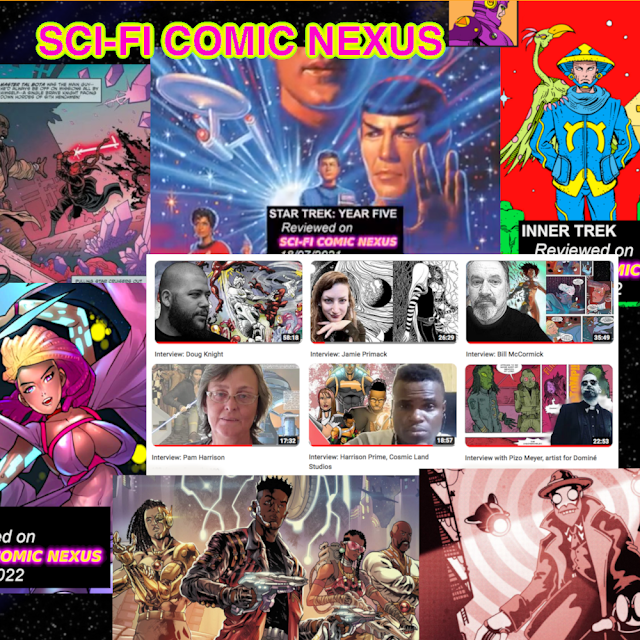Review: Saga
Hazel is special. Her young parents should be mortal enemies - they are from opposite sides of a war that has raged on for many years - but apparently love conquers all...
Her mother Alanna is from the planet Landfall. Her people have wings of various kinds. Hers are like those of an insect.
Hazel's father Marko is from Landfall's moon Wreath. The people there have horns of various kinds. His are like those of a ram.
Landfall and Wreath are locked in a perpetual state of war, but in the interests of environmental conservation their war has been outsourced.... to the rest of the universe.
The destruction of either Landfall or Wreath would result in the demise of both worlds, so they have subcontracted their conflict to other planets. All the bloodshed occurs far away and mostly involves other races, so the civilian populations of Landfall and Wreath go about their lives without much inconvenience.
When private Alanna is put in charge of guarding captured enemy combatant Marko they begin a highly illegal romance... a secret that becomes difficult to keep once Alanna becomes pregnant...
Saga by writer Brian K. Vaughan and artist Fiona Staples is the award-winning story of a family on the run and those sent to hunt them down. Hazel narrates the proceedings, offering interesting little insights here and there. Their journeys take them to many worlds in a universe populated by many species (some humanoid, some animal, mostly a blend of the two).
The supporting cast also includes a ghostly babysitter (teenage war victim Alexis, missing the lower half of her spectral body), a half-woman/half-giant spider bounty hunter (and her human ex-lover, also a mercenary) and the Robot Kingdom (a race of grey-hued people with television sets for heads whose culture resembles Edwardian England, complete with a pompous military brass and a privileged royalty).
This is a surreal tale of adventure vividly brought to life by Staples, whose artwork is finely detailed, combining a fresh, vibrant feel with a precise naturalism of form. She delivers the goods in the many action sequences and also in the dramatic human(oid) moments, such as the emotional bumps in the road of Alanna and Marko's tested-to-breaking-point relationship. Their rocket tree ship takes them to many exotic locations, all of which are deftly illustrated. They struggle with parenthood, anxiety, temptation, drug use and surviving in a hostile universe. Marko struggles with his pacifism, whereas Alanna is willing to do anything to protect her family.
It also takes in a variety of social and political issues, including sexual diversity and racial prejudice (Alanna and Marko's species are supposed to be genetically incompatible; Hazel's arrival showing this to be empty propaganda).
Then there is the question of a populace's acceptance of its nation's foreign policy. Who cares who is dying for your country as long as you can still party?
All of the characters - no matter how bizarre they look - act all-too-human with all the flaws and foibles of homo sapiens. This is another sci-fi setting in which the alien nature of the actors is simply a metaphor for superficial differences in nationality or culture. The interstellar arena is an entertaining backdrop for the complex dramas to play out upon.
This ironic down-to-earth nature creates a lot of empathy in the reader. No matter how powerful our heroes are, they are also vulnerable and prey to their own weaknesses as well as to the many dangers around them. There is a lot here for readers to identify with, which accounts for the popularity of the title.
There are also lots of curious little unique touches: Marko's people can use a technology that is indistinguishable from magic, casting spells in their native language 'Blue' (the dialogue rendered in blue text), the Robots are perplexingly biological from the neck down, their head-screens are mostly blank but sometimes show their thoughts or dreams (only the upper classes having images in colour; commoners are black and white). Sexual scenes are depicted graphically, so this is for mature readers only.
Saga began in 2012 and has been a huge success. Currently running to 54 issues it is on a hiatus; Vaughan estimates it will eventually run to 108 issues. It has also garnered numerous awards, including twelve Eisner and seventeen Harvey Awards between 2013 and 2017. The first trade paperback collection won the 2013 Hugo Award for Best Graphic Story.
Due to popular demand the first issue sold out three times, eventually selling over 700,000 copies. Critics have praised both the writing and the artwork, earning it high status among comics in general, making it probably one of the most successful science fiction comics so far.
This is a much-loved work, and deservedly so. Hopefully the hiatus will end soon and the saga will continue.
SAGA on Image Comics. (Issue One free to read online)
Zak Webber




Comments
Post a Comment